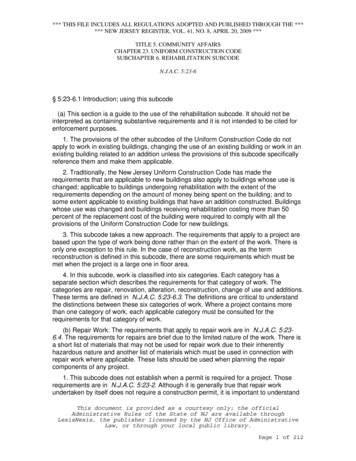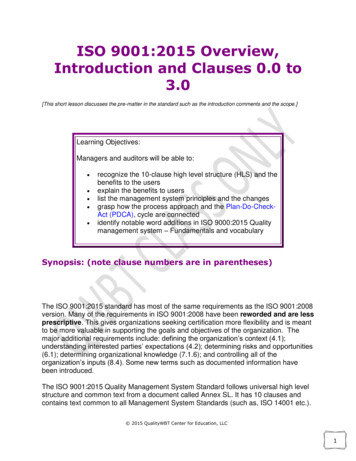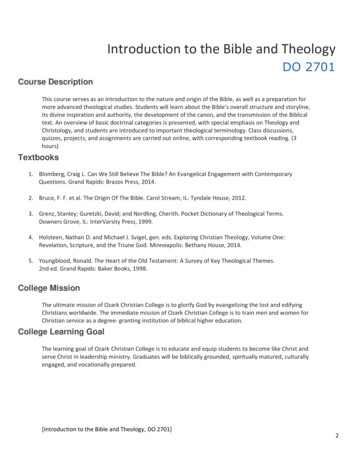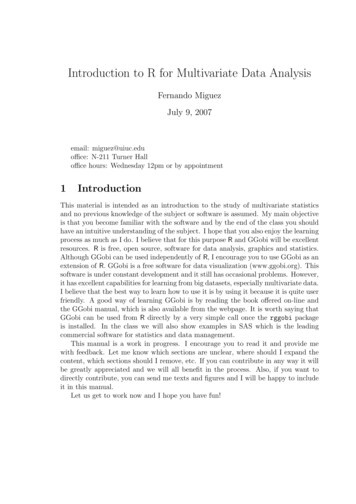
Transcription
N.J.A.C. 5:23-6.1This file includes all Regulations adopted and published through the New Jersey Register, Vol. 53 No. 4, February16, 2021NJ - New Jersey Administrative Code TITLE 5. COMMUNITY AFFAIRS CHAPTER 23.UNIFORM CONSTRUCTION CODE SUBCHAPTER 6. REHABILITATION SUBCODE§ 5:23-6.1 Introduction; using this subcode(a)This section is a guide to the use of the rehabilitation subcode. It should not be interpreted as containingsubstantive requirements and it is not intended to be cited for enforcement purposes.1.The provisions of the other subcodes of the Uniform Construction Code do not apply to work inexisting buildings, changing the use of an existing building or work in an existing building related to anaddition unless the provisions of this subcode specifically reference them and make them applicable.2.Traditionally, the New Jersey Uniform Construction Code has made the requirements that areapplicable to new buildings also apply to buildings whose use is changed; applicable to buildingsundergoing rehabilitation with the extent of the requirements depending on the amount of money beingspent on the building; and to some extent applicable to existing buildings that have an additionconstructed. Buildings whose use was changed and buildings receiving rehabilitation costing more than50 percent of the replacement cost of the building were required to comply with all the provisions of theUniform Construction Code for new buildings.3.This subcode takes a new approach. The requirements that apply to a project are based upon thetype of work being done rather than on the extent of the work. There is only one exception to this rule.In the case of reconstruction work, as the term reconstruction is defined in this subcode, there aresome requirements which must be met when the project is a large one in floor area.4.In this subcode, work is classified into six categories. Each category has a separate section whichdescribes the requirements for that category of work. The categories are repair, renovation, alteration,reconstruction, change of use and additions. These terms are defined inN.J.A.C. 5:23-6.3. The definitions are critical to understand the distinctions betweenthese six categories of work. Where a project contains more than one category of work, eachapplicable category must be consulted for the requirements for that category of work.(b)Repair Work: The requirements that apply to repair work are inN.J.A.C. 5:23-6.4. The requirements for repairs are brief due to the limited nature of the work.There is a short list of materials that may not be used for repair work due to their inherently hazardous natureand another list of materials that must be used in connection with repair work where applicable. These listsshould be used when planning the repair components of any project.1.This subcode does not establish when a permit is required for a project. Those requirements are inN.J.A.C. 5:23-2. Although it is generally true that repair work undertaken by itself doesnot require a construction permit, it is important to understand that any repair work undertaken inconnection with a project that involves other categories of work is required to meet only the provisionsfor the repair category established by this subcode. There is no limit to the amount of repair work whichmay be undertaken. The decision to renovate rather than repair is made only by the owner.2.The installation of smoke alarms is required in any building of Groups R-3, R-4, R-5, and in dwellingunits of Group R-2 that undergo a repair.
Page 2 of 8N.J.A.C. 5:23-6.13.The installation of carbon monoxide detection equipment is required in buildings containing a fuelburning appliance or having an attached garage.(c)Renovation Work: The requirements that apply to renovation work are inN.J.A.C. 5:23-6.5. Renovation is defined inN.J.A.C. 5:23-6.3.1.There are short lists of materials that may not be used and materials or practices which must beused, where applicable, when renovation work is undertaken. These lists should be used whenplanning a project which involves renovation work.2.The installation of smoke alarms is required in any building of Groups R-3, R-4, R-5, and in dwellingunits of Group R-2, which undergoes a renovation.3.The installation of carbon monoxide detection equipment is required in buildings containing a fuelburning appliance or having an attached garage.4.Renovation work must comply withN.J.A.C. 5:23-6.8, Materials and methods. All materials used for the renovation workmust meet the standards for those materials established byN.J.A.C. 5:23-6.8and methods of installation must comply with that section.N.J.A.C. 5:23-6.8, Materials and methods, references and makes applicable torenovation work certain specified subsections of the other subcodes of the Uniform Construction Code.Only those subsections specifically referenced inN.J.A.C. 5:23-6.8apply to renovation work. All materials and methods used inrenovation work must comply with the requirements of that section.5.This subcode never requires renovation. Any existing work may be repaired. The requirements forrenovation apply only where the owner decides to renovate.(d)Alteration Work: The requirements that apply to alteration work are inN.J.A.C. 5:23-6.6. Alteration is defined inN.J.A.C. 5:23-6.3.1.N.J.A.C. 5:23-6.6, Alteration work, contains short lists of materials that may not beused and materials or practices which must be used, where applicable, when alteration work isundertaken. These lists should be used when planning a project which includes alteration work.2.The installation of smoke alarms is required in any building of Groups R-3, R-4, R-5, and in dwellingunits of Group R-2, which undergoes an alteration.3.The installation of carbon monoxide detection equipment is required in buildings containing a fuelburning appliance or having an attached garage.4.Alteration work must also comply with materials and methods that are set forth inN.J.A.C. 5:23-6.8.5.In alteration work, the configuration of the building is changed in some manner. The definition of"alteration" inN.J.A.C. 5:23-6.3provides the information needed to fully understand this term.Because improper alteration work could create a safety hazard in the building, this subcode containsspecific requirements which define these hazards. These are the basic requirements of the subcodewhich can be found inN.J.A.C. 5:23-6.10through6.30.6.The subcode includes basic requirements, listed by group, with the exception of egress capacity,interior finish requirements, commercial cooking operations, and windowless stories which apply to allgroups. Reference should be made to the list of basic requirements applicable to the particular group inwhich the building being altered falls. Care should be taken to ensure that the alteration will not create
Page 3 of 8N.J.A.C. 5:23-6.1a non-conformity with any of the basic requirements which did not exist before the alteration wasundertaken.7.Certain alterations create what are defined to be new building elements. There is a specific listing ofthose items which are to be treated as newly-created building elements which can be found inN.J.A.C. 5:23-6.9. The elements on that list are required to conform to certain specificsections of the other subcodes of the Uniform Construction Code. The sections with which each newlyconstructed element must comply are listed inN.J.A.C. 5:23-6.9. Any alteration which creates one of the elements listed in that sectionmust comply with the specific requirements listed inN.J.A.C. 5:23-6.9.8.Improvements to the accessibility of buildings may be required when alteration work is undertaken.Those requirements are specified inN.J.A.C. 5:23-6.6(e)and (k).(e)Reconstruction Work: The requirements that apply to reconstruction work are inN.J.A.C. 5:23-6.7. Reconstruction is defined inN.J.A.C. 5:23-6.3. Unlike repair, renovation, and alteration, reconstruction is not a kind of work. Areconstruction may, as the definition of the term makes clear, include a combination of repair, renovation, andalteration work. It is the extent and nature of the work which makes a project a reconstruction. There are noquantitative criteria which determine whether a project is a reconstruction. A project becomes a reconstructionwhen the area where the project is taking place cannot be occupied while the work is in progress and when anew certificate of occupancy is required before the area can be re-occupied. Both criteria must be met.1.This subcode requires that a reconstruction project have a delineated work area. This area isestablished by the permit applicant. The term "work area" is defined inN.J.A.C. 5:23-6.3. A reconstruction project must always involve an entire use, primaryfunction space, or tenancy as those three terms are defined inN.J.A.C. 5:23-6.3. Projects which do not involve an entire use, primary function space,or tenancy are not reconstruction projects.2.Although a reconstruction project is comprised of repair, renovation and alteration work, all of therequirements that apply are found inN.J.A.C. 5:23-6.7. For ease of use, this section has been written to include all of therequirements applicable to reconstruction. The entire work area must conform to the basicrequirements inN.J.A.C. 5:23-6.10through6.30. These sections must be carefully reviewed when a reconstruction project is beingplanned.3.The basic requirements are organized by individual groups inN.J.A.C. 5:23-6.12through6.28. Only the sections relevant to the building's group must be consulted. Where aproject involves mixed uses, then the special provisions ofN.J.A.C. 5:23-6.29should also be consulted. Basic requirements that apply to all groupsare inN.J.A.C. 5:23-6.11and6.30. Therefore,N.J.A.C. 5:23-6.11,6.30, and the specific group section between 6.12 and 6.28 must be consulted for thebasic requirements which apply to a project.4.In addition to meeting the basic requirements, certain reconstruction projects must meet thesupplemental requirements found inN.J.A.C. 5:23-6.10through6.30. There is a specific section for each group as is the case with the basic
Page 4 of 8N.J.A.C. 5:23-6.1requirements. Supplemental requirements that apply to all groups are inN.J.A.C. 5:23-6.11Aand6.30. The supplemental requirements apply only when the work area for areconstruction project exceeds a certain size. Each supplemental requirement has its own threshold ofapplicability.5.The owner of a building in which a reconstruction project is planned must review the supplementalrequirements applicable to the use of the project to determine if any of those requirements applies tothe project. In addition to the specific group section betweenN.J.A.C. 5:23-6.12Aand6.28A,N.J.A.C. 5:23-6.11Aand6.30should be consulted for the supplemental requirements that apply to a project.(f)Applying the Subcode to a Project: The requirements of this subcode applicable to a project can be found asfollows:1.Separate the project into its component parts of repair, renovation, and alteration;2.Where a portion of the work is repair, consult the repair section of this subcode (N.J.A.C. 5:23-6.4) to ensure that prohibited materials are not being used and that anyapplicable required materials or practices are being used;3.Where a portion of the work is renovation:i.Consult the renovation sections of this subcode (N.J.A.C. 5:23-6.5);ii.Ensure that the renovation work does not use any prohibited materials and that any applicablerequired materials or practices are being used; andiii.Ensure that renovation materials and the methods of their installation conform to the Materialsand Methods section of this subcode (N.J.A.C. 5:23-6.8).4.Where a portion of the work is alteration work:i.Consult the alteration section of this subcode (N.J.A.C. 5:23-6.6);ii.Ensure that the alteration work does not use any prohibited materials and that any applicablerequired materials or practices are being used;iii.Ensure that any materials and methods used for the alterations conform to the requirements ofthe materials and methods section of this subcode (N.J.A.C. 5:23-6.8);iv.Ensure that alteration which creates a new building element listed inN.J.A.C. 5:23-6.9conforms to the requirements for new building elements that arespecified inN.J.A.C. 5:23-6.9; andv.Ensure that none of the alteration work creates a new condition which would create a violation ofany of the basic requirements applicable to the groups that are specified inN.J.A.C. 5:23-6.10through6.30.5.Determine whether the project is a reconstruction project according to the definitions inN.J.A.C. 5:23-6.3. When the project is a reconstruction project:i.Establish the work area of the project and show it on the plans and/or permit application;
Page 5 of 8N.J.A.C. 5:23-6.1ii.Ensure that the requirements applicable to the repair, renovation, and alteration portions of theproject are followed;iii.Ensure that the basic requirements for the particular uses that are specified in the relevantsection of this subcode betweenN.J.A.C. 5:23-6.11and6.28are followed. Where the project work area includes more than one group,thenN.J.A.C. 5:23-6.29should be consulted; andiv.Review the size of the work area against the relevant provisions of the supplementalrequirements inN.J.A.C. 5:23-6.11Athrough6.28A. Where compliance with a supplemental requirement is necessary, thenensure that the plans and/or the permit application reflect compliance with the required section.Some supplemental requirements will require work outside the work area.(g)Changes of Use: The Uniform Construction Code divides all buildings into categories called uses. TheRehabilitation Subcode uses these same classifications.1.The different uses represent different hazards and different needs. Specific requirements apply toeach use. Each of the other technical subcodes of the Uniform Construction Code: Building, Fire,Plumbing, Electrical, Mechanical, Fuel Gas, Energy, and One- and Two-Family Dwelling, defines theseuses, each for its own purpose. Traditionally, the Uniform Construction Code required any building orportion of a building where the use was changed to conform to the requirements of the code for a newbuilding of that use. This subcode takes a different approach.2.A change of use in a building often, but not always, involves some construction work. Changes ofuse, in which the owner does not need any construction work to effect the new use, do happen. Thedifferent uses defined by the code reflect different levels of hazard and different safety requirements.Depending upon the specific change, a new use may not affect the hazard; it could pose a lesserhazard; or it might pose a greater hazard or necessitate additional safety measures.3.This subcode allows changes of use where the new use is similar to or less demanding in terms ofhazard or safety requirements than the present use. No modifications to the building are required bythis subcode where such a change of use is planned.4.This subcode uses the concept of hazard indexes in order to specify the requirements for a change ofuse. Separate hazard indexes are established for different aspects of building, health, and safety:i.Basic Requirements: Changes of use specified inN.J.A.C. 5:23-6.31(b)must comply with the basic requirements set forth inN.J.A.C. 5:23-6.10through6.30before the building can be occupied for the new use.ii.Means of Egress: Certain changes of use specified inN.J.A.C. 5:23-6.31(c)must comply with additional requirements for egress whichare set forth inN.J.A.C. 5:23-6.31(c)before the building can be occupied for the new use.iii.Vertical Openings: Stairways and other vertical openings located in a building or portion of abuilding where there is a change of use are required to meet certain enclosure requirements for thenew use which are specified inN.J.A.C. 5:23-6.12through6.28. These requirements must be met before the building may be occupied forthe new use.iv.Height and Area Limits: Changes of use are not allowed if the building will exceed the height andarea limits specified in
Page 6 of 8N.J.A.C. 5:23-6.1N.J.A.C. 5:23-6.31(e)defined inN.J.A.C. 5:23-3.14for its type of construction. The types of construction are, the Building Subcode.v.Exterior Walls: Changes of use as specified inN.J.A.C. 5:23-6.31(f)of this subcode must have the fire resistance of exterior wallsand any openings therein improved as specified inN.J.A.C. 5:23-6.31(f)before the building can be occupied for the new use.vi.Automatic Sprinkler System: Changes of use as specified inN.J.A.C. 5:23-6.31(g)must have an automatic sprinkler system installed inaccordance with the requirements ofN.J.A.C. 5:23-6.31(g)before the building can be occupied for the new use.vii.Fire Alarms and Fire Detection Systems: Changes of use as specified inN.J.A.C. 5:23-6.31(h)and (i) must have fire alarms or fire detection installed inaccordance with the requirements ofN.J.A.C. 5:23-6.31(h)and (i) before the building can be occupied for the new use.viii.Structural, Plumbing, Electrical, and Mechanical: Some changes of use may necessitatechanges to the structural, plumbing, electrical, or mechanical systems of a building. Theserequirements are set forth inN.J.A.C. 5:23-6.31(k), ( l), (m) and (n) of this subcode. Only those requirementsnecessitated by the change and needed for health or safety in the new use as specified must bemet.ix.Accessibility Requirements: Changes of use must conform to the accessibility requirementsspecified inN.J.A.C. 5:23-6.31( o) before the building can be occupied for the new use.5.Where the owner of a building undergoing a change of use decides to undertake work not required byN.J.A.C. 5:23-6.31, then that work must comply with the requirements for repair,renovation, alteration, and reconstruction, as the case may be, which are established byN.J.A.C. 5:23-6.4,6.5,6.6and6.7.6.Where the use of a building or portion of a building is changed, a new certificate of occupancy isrequired for the new use by the provisions ofN.J.A.C. 5:23-2. This does not mean that all changes of use are required to meet therequirements for reconstruction. Only a project which meets the definition of reconstruction set forth inN.J.A.C. 5:23-6.3need comply with the provisions ofN.J.A.C. 5:23-6.7, Reconstruction.(h)Additions: Additions are required to comply with the provision of the other technical subcodes of the UniformConstruction Code. Work in the existing building which is related to the addition must conform with therequirements ofN.J.A.C. 5:23-6.32. Additionally, such work undertaken in the existing building must comply withthe requirements for repair, renovation, alteration, and reconstruction as set forth inN.J.A.C. 5:23-6.4,6.5,6.6and6.7.(i)Historical Buildings:N.J.A.C. 5:23-6.33defines those buildings which are to be treated as historic and sets forth certainspecial requirements applicable to historic buildings which modify the provisions of this subcode when a
Page 7 of 8N.J.A.C. 5:23-6.1building is historic.N.J.A.C. 5:23-6.33should be reviewed to determine if a building is to be treated as historic underthis subcode and for the special provisions applicable to the various types of historical buildings.HistoryHISTORY:Amended by R.2000 d.492, effective December 18, 2000.See:32 N.J.R. 3219(a)32 N.J.R. 4437(b),.In (a)3, deleted the last sentence; and in (d)7, updated N.J.A.C. reference.Amended by R.2003 d.218, effective May 19, 2003.See:35 N.J.R. 29(a)35 N.J.R. 2209(a),.In (c)2 and (d)2, substituted "R-3 and R-5" for "R-3/R-4"; in (f)5iii, (g)4ii, and (g)4vii, updated N.J.A.C.references.Amended by R.2004 d.145, effective April 5, 2004.See:35 N.J.R. 5190(a)36 N.J.R. 1758(a),.Deleted references to use preceding references to group throughout; in (g)4vi, substituted referencesto automatic sprinkler system for fire suppression throughout.Amended by R.2009 d.117, effective April 20, 2009.See:41 N.J.R. 18(a)41 N.J.R. 1726(a),.In (c)2 and (d)2, substituted "alarms" for
NJ - New Jersey Administrative Code TITLE 5. COMMUNITY AFFAIRS CHAPTER 23. UNIFORM CONSTRUCTION CODE SUBCHAPTER 6. REHABILITATION SUBCODE § 5:23-6.1 Introduction; using this subcode (a)This section is a guide to the use of the rehabilitation subcode. It should not be interpreted as containingFile Size: 2MB











